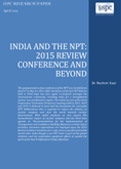Rafale and Indian Art of Defence Purchases
The decision to buy 36 Rafale fighters exposes the complexinstitutional mechanisms in defence procurement.
The decision to buy 36 Rafale fighters exposes the complexinstitutional mechanisms in defence procurement.

The quinquennial review conference of the NPT is to be held from April 27 to May 22, 2015. After the failure of the last NPT RevCon held in 2010 hope has once again re-surfaced amongst the international community, including India for a strengthened nuclear non-proliferation regime. The initial success of the three Preparatory Committee (PrepCom) meetings held in 2012, 2013 and 2014 is believed to have laid the foundation for successful NPT deliberations that is expected to reduce the salience on nuclear weapons and steer the world towards nuclear disarmament.
Indian Prime Minister Narendra Modi’s appeal to the global manufacturers through his independence day speech on 15 August, 2014 – come, manufacture here, sell us and others (anywhere) – has generated varying degrees of attention in India and elsewhere. Whether such an avowal is a byproduct of a crafted political vision or a mere popular adventurism is a matter of debate.
A recent New York Times editorial (India’s Role in the Nuclear Race), has recommended that the issue of India’s entry into the Nuclear Suppliers’ Group (NSG) be restricted till India “proves itself willing to take a leading role in halting the spread of the world’s most lethal weapons.” The editorial has premised India’s NSG membership upon fulfillment of three conditions: Signing the Comprehensive Test Ban Treaty (CTBT), halting
In his famous 1990 essay in Foreign Affairs, Charles Krauthammer had declared that the unipolar moment had arrived. He had listed a few reasons to support his argument; there was no challenging power, nor was there likely any in the few decades, there was no power dispersion at the international level at that moment, the former Soviet Union’s capacity was in a decline. Thus, Krauthammer emphasised, at that time there was no first-rate power in the world that could match the capacity of the US.
December 20, 2013, will be marked as a proud day for India and its military scientific and industrial sectors as the indigenously designed and developed Tejas (India’s light multi-role fighter aircraft, known as LCA) gets its second and most important initial operational clearance (IOC). While the final operational clearance (FOC) will take about 18 months, after which Tejas will be formally a part of combat forces of the Indian Air Force (consequently by the Indian Navy as well), the process of induction of Tejas into IAF is now a reality after IOC.
The protracted rivalry between India and Pakistan had reached its lowest ebb and virtually plumbed new depths when both the countries detonated a series of nuclear devices way back in May 1998. This overt gesture and successive developments (such as Kargil) made the region a major nuclear flashpoint in the world. Nearly after six years, two warring neighbors have decided to sit across the table to hammer out the much needed confidence building measures (CBMs).
Syrian crisis has achieved the unachievable. It has compelled a communist country to talk peace and democratic/capitalist countries to talk war. Fortunately, it appears that the invasion of Syria by the US forces has been stopped, at least, temporarily. An agreement on chemical weapons stockpiled in Syria has been reached following the talks held in Geneva between the Foreign Minister of Russia, Sergey V. Lavrov, and US Secretary of State John Kerry.
The genesis of 'Directed Energy Weapon' (DEWs) came up during cold war when Karl Bendetson and the High Frontier panel of private citizens advised President Ronald Reagan for a crash program to develop missile defenses. It was not just to defend against Soviet nuclear weapons but also because of strong indications that the Soviets were going to deploy 'powerful directed energy weapons' in space to gain control of space by using weapons like lasers, jammers etc. Towards the end of Cold War, the US focused on ballistic missile defence and spending on DEWs.
The Hague Code of Conduct against Ballistic Missile Proliferation (HCoC) has completed ten years of its existence. This code was formally brought into effect on November 25, 2002, at a conference hosted by the Netherlands at The Hague. This was also known as the International Code of Conduct (ICOC). This code is voluntary and not-binding in nature and mainly expects the subscribing states to furnish annual declarations on missile policy and the pre-launch notifications (PLNs) of missile test launches.
Paxton ported to drupal by DropThemes.in